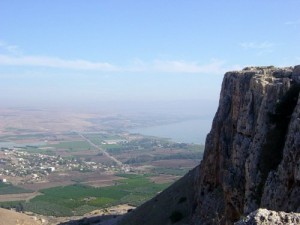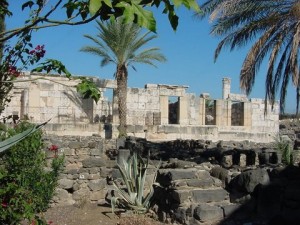Mark 2:1 “A few days later, when Jesus again entered Capernaum, the people heard that he had come home.”
Although Jesus (Yeshua) was born in Bethlehem of Judah he spent his boyhood years in Nazareth, a city located much further north in the lower Galilee. Jesus must have had that special Galilean accent in his speech, as did Peter and probably most of the other disciples (Mk. 14:70). When Jesus began his ministry he moved from Nazareth to Capernaum, which was located on the north shore of the Sea of Galilee.
Why would Jesus make such a move? Did he like the sub-tropical climate found at the sea? Did He like to fish? The real reason he came to Capernaum was to fulfill scripture. It is stated in Isaiah 9:1-2: “Nevertheless, there will be no more gloom for those who were in distress. In the past he humbled the land of Zebulun and the land of Naphtali, but in the future he will honor Galilee of the Gentiles, by the way of the sea, along the Jordan—The people walking in darkness have seen a great light; on those living in the land of the shadow of death a light has dawned.” In Matthew 4:13-16, this verse is applied to Jesus, and it is stated as the reason he came to Capernaum.
We realize from the earlier passage in Isaiah the incredible accuracy of biblical prophecy. Isaiah was speaking over seven hundred years before the coming of the Lord. While Nazareth is in the tribal area of Zebulun, Capernaum is situated in Naphtali. Both these tribal names are mentioned in Isaiah. According to the Talmud, the tribe of Napthali controlled the area around the Sea of Galilee and they were the fishing tribe (BT Baba Kama). Isaiah, in the above passage, also mentions that Jesus’ ministry would be in the area of the Jordan River. Jesus often crossed the Jordan into the area of Herod Philip which was known in that time as Gaulinitis. Today this area is part of the Golan Heights.
There was also an ancient roadway running through this area. Scholars have contested its actual route but it came from the Mediterranean Sea to the Sea of Galilee, and ran through Capernaum. This road was called “The Way of the Sea.” There is a possibility that the Romans even gave it the name Via Maris (also meaning “Way of the Sea”). In fact, today there is a Roman mile marker from this ancient road displayed at Capernaum.
PETER’S HOUSE
Not only did Jesus make Capernaum his home, but it appears from scripture that some of the other disciples may have moved there. Located prominently in the ruins of Capernaum today is an excavation known as The House of Peter. Underneath the modern church at this site are fifth and fourth-century churches, all built over the remains of a first-century dwelling/church. Archaeologists did not find in this dwelling the usual domestic utensils, but rather inscriptions and markings from early Christian pilgrims. They assume that it was an early Christian meeting place and place of pilgrimage from the first century.*
The House of Peter is mentioned in all four Gospels: “Now as soon as they had come out of the synagogue, they entered the house of Simon and Andrew, with James and John” (Mk. 1:29 NKJV). We know also from this passage that Jesus healed Peter’s mother-in-law, who was also apparently living there. Interestingly, the house is located just a stone’s throw from the synagogue.
THE SYNAGOGUE
Situated prominently in ancient Capernaum is the white stone synagogue, much of it still standing. This present structure has been dated to the fourth century A.D. However, underneath the synagogue is a black basalt foundation of an earlier structure. Some feel this foundation belongs to the synagogue in Jesus’ time.
Jesus must have regularly attended and even ministered in this synagogue. We have several accounts of this in scripture. In Mark 1:21-27, we see Jesus teaching and later casting out an evil spirit there. In John 6:51-69, we see Jesus declaring in this synagogue that man must eat his flesh and drink his blood to have life. Great dissension was aroused concerning this statement. Apparently, many of his disciples forsook him at the time because they did not understand the
true meaning.
Today the surviving frieze work on the fourth-century synagogue tells us much about Jewish life in the fourth century AD. The synagogue was decorated with the traditional flowers, pomegranates, palm trees and other symbols. However, some of the stones indicate that it was also decorated with Hellenistic symbols such as the mythical capricorn (sea horse) and a pair of eagles. These would have been forbidden by Jewish custom in earlier times because of the ever-present danger of idolatry and the commands concerning graven images. From this, we can assume that the Hellenistic way of life with its religious practices was making great inroads into Judaism in the fourth century.
WHEN GOD LIVES WITH YOU
In Scripture, the Messiah is called “Immanuel,” or “God with us” (Isa. 7:14; Matt. 1:23). Immanuel came to live in Capernaum on the Sea of Galilee. Back in those days when one went to the shuk (open market) to buy grapes, he might just happen to see Jesus also buying grapes. Imagine the King of the Universe buying grapes and living as a man! One might also chance to see him work a mighty miracle of healing for someone in the shuk. Apparently, many of those onlookers saw such miracles, shrugged their shoulders, clutched their own grapes and walked away unchanged.
Because of their attitudes, Jesus cursed the city of Capernaum with these words: “And you, Capernaum, will you be lifted up to the skies? No, you will go down to the depths. If the miracles that were performed in you had been performed in Sodom, it would have remained to this day. But I tell you that it will be more bearable for Sodom on the day of judgment than for you.” (Matt. 11:23-24).
We learn a very important lesson here. Revelation demands responsibility. As the scripture says, “…From everyone who has been given much, much will be demanded; and from the one who has been entrusted with much, much more will be asked” (Lk. 12:48). We will give an account for every ounce of revelation we have ever received. It is probably for this reason that teachers will be judged more severely than others (Jas. 3:1).
Jesus, the Son of God, came to live in Capernaum, and it brought great judgment upon that unresponsive city. Conversely, it brought great salvation for those who heard and heeded his message. Jesus, through the Holy Spirit, now lives in each believer’s heart. We can draw out the astounding implications of that fact for ourselves.
Capernaum illustrates for us that we live on a visited planet. He who is called “…Wonderful Counselor, Mighty God, Everlasting Father, Prince of Peace” (Isa. 9:6), came to live with us for a short season at Capernaum. He was a bright and shining light in a dark place. Because of his shining, the Galilee will never be the same – nor will the world for that matter.
– Jim Gerrish
This updated article is presented courtesy of Bridges For Peace, Jerusalem.
*John J. Rousseau, & Rami Arav, Jesus and His World, An Archaeological and Cultural Dictionary, Minneapolis, MN, Fortress Press, 1995, p28


